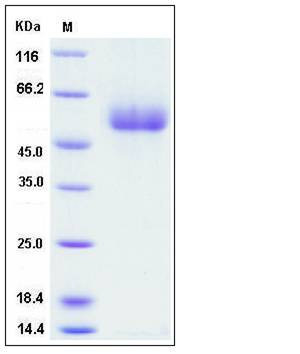Human Apolipoprotein H / APOH Protein (His Tag)
B2G1,B2GP1,BG
- 100ug (NPP3581) Please inquiry
| Catalog Number | P11221-H08H |
|---|---|
| Organism Species | Human |
| Host | Human Cells |
| Synonyms | B2G1,B2GP1,BG |
| Molecular Weight | The recombinant human APOH consists of 337 amino acids and predictes a molecular mass of 37.7 kDa. In SDS-PAGE under reducing conditions, the apparent molecular mass of rhAPOH is approximately 53 kDa due to different glycosylation. |
| predicted N | Gly 20 |
| SDS-PAGE |  |
| Purity | > 96 % as determined by SDS-PAGE |
| Protein Construction | A DNA sequence encoding the human APOH (NP_000033.2) (Met 1-Cys 345) was expressed, with a polyhistidine tag at the C-terminus. |
| Bio-activity | 1. Measured by its binding ability in a functional ELISA. 2. Immobilized human APOH-his at 2 μg/mL (100 μl/well) can bind biotinylated human LDLR-his, The EC50 of biotinylated human LDLR-his is 0.35 μg/mL. 3.Immobilized human APOH-his at 2 μg/mL (100 μl/well) can bind biotinylated mouse LDLR-his, The EC50 of biotinylated mouse LDLR-his is 26 ng/mL. |
| Research Area | Cardiovascular |Lipids / Lipoproteins |Lipid Metabolism |
| Formulation | Lyophilized from sterile PBS, pH 7.4 1. Normally 5 % - 8 % trehalose and mannitol are added as protectants before lyophilization. Specific concentrations are included in the hardcopy of COA. |
| Background | Apolipoprotein H (APOH), also known as Beta-2-glycoprotein 1, Activated protein C-binding protein, B2GPI, and B2G1, is a glycoprotein synthesized by liver cells and it is present in the blood associated with plasma lipoproteins. It is an essential cofactor for the binding of certain antiphospholipid antibodies (APA) to anionic phospholipid. APOH binds to various kinds of negatively charged substances such as heparin, phospholipids, and dextran sulfate. APOH may prevent activation of the intrinsic blood coagulation cascade by binding to phospholipids on the surface of damaged cells. APOH appears to completely inhibit serotonin release by the platelets and prevents subsequent waves of the ADP-induced aggregation. The activity of APOH appears to involve the binding of agglutenating, negatively charged compounds, and inhibits agglutenation by the contact activation of the intrinsic blood coagulation pathway. APOH causes a reduction of the prothrombinase binding sites on platelets and reduces the activation caused by collagen when thrombin is present at physiological serum concentrations of APOH suggesting a regulatory role of APOH in coagulation. APOH plasma concentrations are strongly associated to metabolic syndrome alterations and vascular disease in type 2 diabetic and could be considered as a clinical marker of cardiovascular risk. APOH is found on several classes of lipoproteins, and is involved in the activation of lipoprotein lipase in lipid metabolism. This single-chain glycoprotein also has been implicated in several physiologic pathways including coagulation and the production of hypertension, which are related to the pathogenesis of primary cerebral hemorrhage (PICH). |
| Reference |
